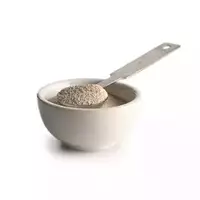Dry yeast

Unicellular microorganisms that differ in plant origin, this is yeast. Their main property is to promote fermentation processes. For fermentation and baking, man began to use yeast several tens of centuries ago. By the way, the word yeast is characterized by pre-Slavic origins - it comes from a verb that means to crush or knead.
Not so long ago, yeast could be purchased in a single version - in the form represented by pressed briquettes. Such a product had its advantages: in particular, fresh yeast was in full combat readiness. However, they also had disadvantages - due to the high moisture content, pressed yeast could not be stored for long.
To solve the eternal problem of food products, which concerns the extension of their shelf life, yeast began to dry, thereby facilitating their transition from active to sleeping. But this approach has largely extended the shelf life of dry yeast - from twelve days to almost two years.
Now consumers who can buy dry yeast in the store do not have to do it on the eve of baking - they can be bought in reserve. In addition, for stores, dry yeast is largely more profitable than pressed yeast - they do not require special storage conditions and take up a little space.
It is often necessary to replace compressed yeast with dry yeast, for which there is a special ratio of these products. As a rule, 50 grams of fresh is replaced by one bag of dry yeast (about 10-11 grams). The calorie content of dry yeast is about 325 kcal per 100 grams.
Composition of dry yeast
Dry yeast contains a significant amount of protein, valuable and useful for humans - it is well digested and absorbed. In addition, dry yeast is rich in carbohydrates - on average, their amount is eighteen percent.
There are vitamins PP, C and group B in the composition of dry yeast. There are also useful mineral salts in them, which are so necessary for the normal activity of the human body - magnesium, phosphorus, zinc, potassium, calcium, copper, manganese, selenium, sodium and iron.
Harm to dry yeast
A lot is known about the benefits of this product, but there are also facts that indicate the obvious harm of dry yeast. So, for example, they are able to undermine human immunity - gradually accumulating in the body, yeast weakens its defenses, making it more susceptible to various diseases.
In addition, by multiplying rapidly in the body, dry yeast destroys the useful microflora of the gastrointestinal tract, favoring the penetration of pathogens into the cells of the digestive organs, into the blood and into the body as a whole.
dry yeast 325 kCal
Energy value of dry yeast (Ratio of proteins, fats, carbohydrates - ju):
Proteins: 40.44 g (~ 162 kCal)
Fats: 7.61 g. (~ 68 kCal)
Carbohydrates: 14.32 g (~ 57 kCal)
Energy ratio (bj | y): 50% | 21% | 18%
 Español
Español Français
Français Português
Português Русский
Русский 简体中文
简体中文 繁體中文
繁體中文 日本語
日本語 한국어
한국어 العربية
العربية Türkçe
Türkçe Қазақ
Қазақ Deutsch
Deutsch Italiano
Italiano Українська
Українська
